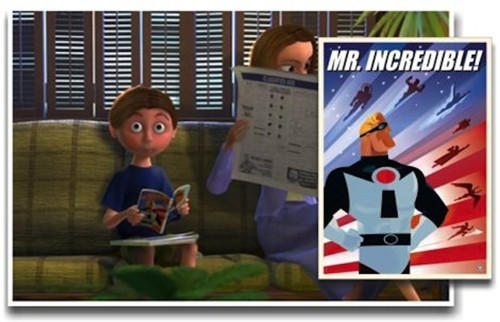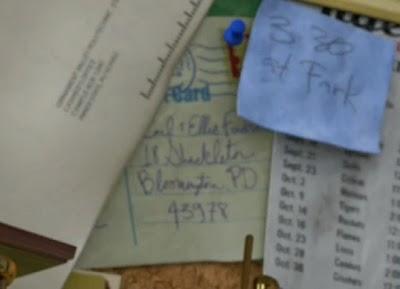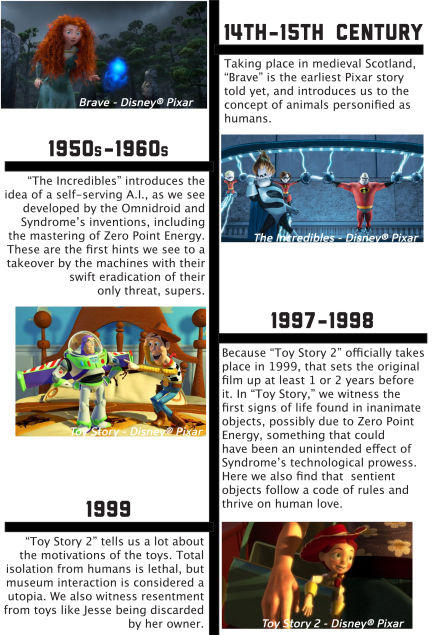About
The Pixar Theory is a hypothesis which posits that every movie produced by Pixar Animation Studios[1] exists within the same universe in a linear timeline. The notion was first popularized in July 2013 after blogger Jon Negroni fleshed out his theory on his personal website.
Origin
As early as September 2009, fans from the Pixar Planet[2] message board theorized about whether or not Pixar’s films existed in the same universe. In nearly 50 discussion posts, fans noted that the films sometimes offered small nods to each other, including a child reading a The Incredibles comic in Finding Nemo (shown below, left) and a postcard with Up characters Carl and Ellie’s home address appearing in the trailer for Toy Story 3 (shown below, right).
Spread
In June 2010, the theory was discussed on the IGN forums[3], where many members argued against its plausibility due to the premise of the 2006 film _Cars), which is set in a world of self-driving, anthropomorphic vehicles. Then in August, LiveJournal user lynxgriffin[4] presented a theory involving aspects of the A.I. technology found in Portal and working Cars into the timeline as a sentient race that develops after humans have died out. On September 4th, 2012, Cracked[5] released an episode of the web debate series After Hours in which one of the hosts argues that every Pixar movie takes place in the same universe and therefore is an omen of an inevitable robot apocalypse. However, his theory failed to incorporate a number of Pixar films including Ratatouille, A Bug’s Life and Brave.
Negroni’s Timeline
On July 11th, 2013, Jon Negroni wrote a blog post[6] explaining how all fourteen of Pixar’s feature length films from 1995’s _Toy Story through 2013’s Monsters University are interconnected. According to his theory, the timeline begins in the 14th century with Brave, which introduces the idea that both animals and inanimate objects can behave like humans. As the tension between humans and animals evolves throughout the films, the corporation Buy-N-Large begins to thrive, eventually taking over the world by the year 2100, as portrayed in the 2008 film Wall-E (shown below).
Following the exile of the human race from Earth, machines and cars take over. This leads up to the distance future where monsters have become the dominant race, although they need human screams to survive. They invent time traveling doors to travel back to human times, by which a monster named Sully meets a young girl named Boo. After the monsters move on, Boo learns how to use these magical doors to seek out her monster friend and ends up traveling back to the 14th century, where her now-elderly self appears as a witch in Brave.
Reception
The same day, Negroni’s Pixar theory was submitted to /r/FanTheories[7] and /r/Movies[8], where it gained more than 1,100 and 2,000 overall points, respectively. Also on July 11th, the theory was discussed on a handful of message boards including MMA Junkie[9], NeoGAF[10] and AltTabMe.[11] The following day, the theory was discussed on nmerous pop culture blogs and news sites including Vulture[12], BoingBoing[13], the A.V. Club[14], the Daily Dot[15], Mashable[16], Kotaku[17] and Buzzfeed.[18] On July 15th, Negroni posted a simplified version of his theory in a visual timeline.[19]
Pixar’s Response
On July 18th, Jalopnik[20] reached out to Cars art coordinator and character manager Jay Ward[21] about the theory. He said that none of this was probably intentional, as the films were made in a different order by different directors and teams, but “it’s cool that it all worked out that way.”
Search Interest
External References
[2]Pixar Planet – Are the movies set in the same universe?
[3]IGN– SCENARIO: ALLPIXARMOVIESEXIST IN THESAMEUNIVERSE
[4]LiveJournal – lynxgriffin: Pixar universe speculation madness
[5]Cracked – Why Pixar Movies Are All Secretly About the Apocalypse
[6]Jon Negroni – The Pixar Theory
[7]Reddit – /r/FanTheories: Fan theory that ties the entire Pixar universe together.
[8]Reddit – /r/movies: May I present to you: The Pixar Theory
[9]MMA Junkie – Pixar Theory
[10]NeoGAF – The Pixar Theory
[11]AltTabMe – The Pixar Theory
[12]Vulture – ‘The Pixar Theory’ Posits All Pixar Films Are Connected
[13]BoingBoing – A unified theory of Pixar movies
[14]The A.V. Club – Read This: A grand unified theory connects all Pixar films in one timeline
[15]The Daily Dot – “Pixar Theory” connects all your favorite movies in 1 universe
[16]Mashable – The Pixar Theory: Every Character Lives in the Same Universe
[17]Kotaku – This Theory On How All The Pixar Films Are Connected Is Bonkers
[18]Buzzfeed – This Theory On Pixar Movies Will Blow Your Mind
[19]Jon Negroni – The Pixar Theory Timeline
[20]Jalopnik – Pixar’s Jay Ward Responds To The Unified Pixar Movie Theory



